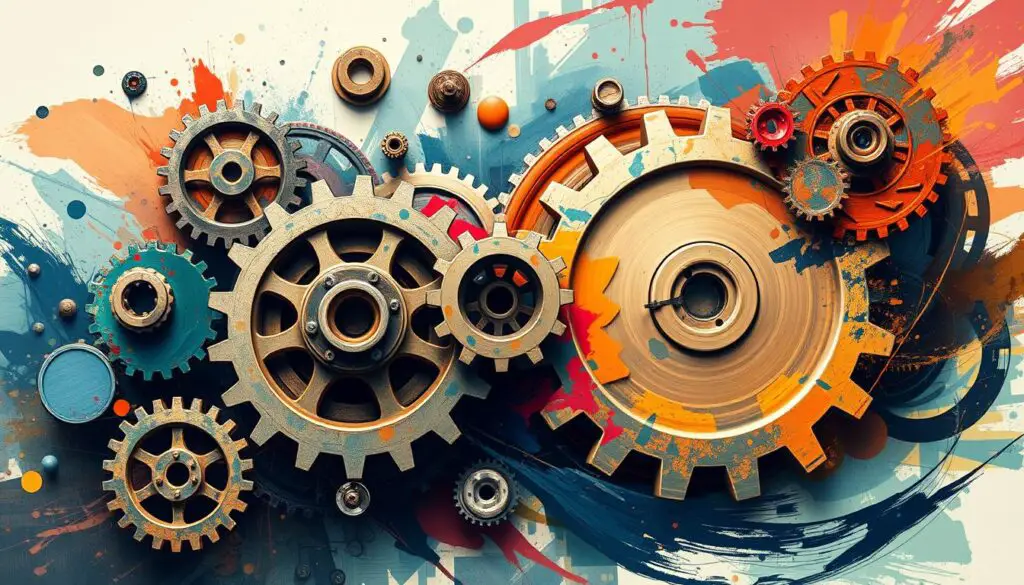We’re seeing a big change in how we use technology, thanks to AI and language models. ChatGPT, a top language model, could change many industries, like customer service and healthcare. Studies say ChatGPT could change how we work and live, making it a big deal in AI.
Language models are key to this change. They let computers talk like humans. ChatGPT is special because it can have real conversations. This makes it useful for businesses and people. We’ll look at what ChatGPT can do and how it will change our lives, using AI and language models.
Let’s dive into the ChatGPT revolution. We’ll see the tech behind it and how it can help different areas. From making things more efficient to changing education, the possibilities are huge. ChatGPT could bring big improvements, thanks to AI and language models.
Key Takeaways
- ChatGPT is a revolutionary language model that can transform the way we interact with technology
- AI technology and language models are driving this revolution, enabling computers to understand and generate human-like text
- ChatGPT has the potential to impact various industries, from customer service to healthcare
- Language models like ChatGPT can drive growth and improvement in automation, education, and other sectors
- The capabilities of ChatGPT are vast, and its potential applications are still being explored
- ChatGPT is poised to revolutionize the way we work and live, making it an exciting development in the field of AI technology
Understanding the Chat GPT Revolution
We’re seeing a big change in how we use technology, and ChatGPT is leading this change. OpenAI, a top AI research group, created ChatGPT. It could change many parts of our lives, like business operations and customer service. ChatGPT uses AI technology to automate tasks, making things more efficient and improving customer service.
ChatGPT’s core is a mix of language models and deep learning algorithms. These tools help ChatGPT understand and answer human questions well. Looking into ChatGPT’s history shows how important language model evolution has been.
- Advances in natural language processing (NLP)
- Improvements in machine learning algorithms
- Increased availability of large datasets for training
These advancements helped create a smart AI model. It can talk, answer questions, and even write text.
Looking ahead, ChatGPT’s uses in business operations and customer service are exciting. With AI technology, we can achieve more efficiency, productivity, and innovation. This will benefit both people and businesses.
The Transformative Power of AI Language Models
We are seeing big changes in education and healthcare thanks to AI. AI language models are making a big difference. They promise better learning and care for patients.
AI language models bring many benefits to education like:
- Personalized learning experiences
- Intelligent tutoring systems
- Automated grading and feedback
In healthcare, AI language models help with:
- Medical diagnosis and research
- Patient data analysis and management
- Chatbots for patient support and engagement
AI is changing how we teach and care for patients. As AI gets better, we’ll see more efficiency and better care.
Here’s a quick look at what AI can do for education and healthcare:
| Industry | Potential Benefits |
|---|---|
| Education | Personalized learning, intelligent tutoring, automated grading |
| Healthcare | Medical diagnosis, patient data analysis, chatbots for patient support |
But, we must think about the challenges of using AI in education and healthcare. This way, we can make sure AI helps us improve care and learning.
ChatGPT’s Impact on Business Operations
Businesses are changing fast, thanks to AI tools like ChatGPT. These tools help make work easier and faster. This means companies can save money and make more money too.
ChatGPT can take over simple tasks, letting people do more important work. This makes work better and more creative. It also helps find important information in big data, helping businesses make smart choices.
- Improved productivity metrics through automation
- Enhanced efficiency in customer service and support
- Data-driven decision making through advanced analytics
ChatGPT is changing how businesses work. By using it, companies can stay ahead and succeed in the long run. It’s all about making work better and more efficient.
| Benefits | Description |
|---|---|
| Automation | Streamlining routine tasks to increase efficiency |
| Efficiency | Improving productivity and reducing costs |
| Business Operations | Enhancing overall performance and decision making |
Revolutionizing Customer Service Through AI
We think AI can change how companies talk to their customers. AI lets businesses offer a more personal and quick service. Tools like chatbots and virtual assistants help solve problems fast.
Using AI for customer service has many benefits:
- AI chatbots can handle many questions at once, saving time.
- They can give advice based on what they know about you.
- They work all the time, so you get help whenever you need it.
As AI gets better, so will customer service. Businesses can offer quicker, more tailored help. This makes customers happier and more loyal.

By using AI, companies can give their customers the best experience. As AI grows, we’ll see even more ways to improve service.
Educational Transformation with ChatGPT
We’re looking into how ChatGPT could change education. It’s all about learning enhancement tools and teaching applications. ChatGPT could make learning more personal, leading to better results for students.
ChatGPT could really change education. Some good things it might bring include:
- Learning plans made just for each student
- More fun and interactive teaching applications
- Better results for students thanks to smart learning enhancement methods
But we must think about the good and the bad of ChatGPT in schools. This way, we can use ChatGPT to make education better and more effective. It will help meet the needs of all students.
Content Creation and Creative Industries
AI technology is changing how we create content. This change is big in creative writing and art. AI tools help writers with characters, story plots, and even full drafts.
In the art world, AI is making new, amazing pieces. Artists use AI to create unique patterns, shapes, and colors. This leads to stunning art we never thought possible. AI also helps keep historical artworks safe for the future.

AI’s impact on content creation is huge. It can bring new ideas and make the creative process better. As AI grows, we’ll see even more cool uses in the future.
Using AI in content creation has many benefits. These include:
- Increased efficiency and productivity
- Improved creativity and innovation
- Enhanced collaboration and communication
As AI technology continues to evolve, we can expect to see new and exciting developments in the world of content creation and creative industries.
Healthcare Applications and Innovations
We are looking into how ChatGPT can change healthcare. This field can really benefit from new tech. ChatGPT could make a big difference by helping with diagnosis and medical research.
Here are some ways ChatGPT can help in healthcare:
- Diagnostic assistance: ChatGPT can help doctors find diseases faster and more accurately.
- Medical research support: It can help researchers sort through big data to find new insights.
- Patient care enhancement: ChatGPT can give patients advice and support tailored just for them.
ChatGPT can make healthcare better by improving patient care. It can also help in medical research, leading to new treatments.
ChatGPT could really change healthcare for the better. As we keep using it, we’ll see big steps forward in medical research and patient care.
| Application | Description |
|---|---|
| Diagnostic Assistance | ChatGPT can help doctors diagnose diseases more accurately and efficiently. |
| Medical Research Support | ChatGPT can assist researchers in analyzing large amounts of data and identifying patterns. |
| Patient Care Enhancement | ChatGPT can help improve patient care by providing personalized recommendations and support. |
Ethical Considerations and Challenges
As we delve into ChatGPT’s abilities, we must think about its ethical sides. Privacy concerns are a big deal, since it needs lots of personal data to work well. We wonder how this data is gathered, kept, and kept safe.
There’s also fear about job market impact. As ChatGPT gets better, it might take over jobs that are repetitive or routine. This could hurt the economy and society a lot.
Another big issue is bias and fairness. If ChatGPT learns from biased data, it might spread and even grow these biases. This is a big worry in hiring, education, and law enforcement, where fairness is key.
To tackle these problems, we need strong rules and regulations for ChatGPT. This could mean laws for data protection, being open about how it works, and checks to make sure it’s fair and accurate.
Future Development Roadmap
We’re excited to look at the future of ChatGPT. We’ll focus on future trends and advancements in AI technology. The future of ChatGPT will see big steps in AI and natural language processing.
Some possible uses of these advancements are:
- Improved language understanding and generation
- Enhanced user experience and interface
- Increased adoption in various industries, such as customer service and education
Looking ahead, AI technology will be key in ChatGPT’s growth. We’ll see new future trends like more machine learning and deep learning.
By leading in these advancements and future trends, ChatGPT will keep changing how we use technology and interact with each other.
Conclusion: Embracing the AI-Driven Future
As we wrap up our look at ChatGPT, it’s obvious that this AI technology is changing the game. It’s making big waves in many areas, like business, education, and healthcare. The impact of ChatGPT is huge and can’t be ignored.
The future of AI technology is both promising and complex. We need to approach this AI-driven future with care. Knowing what ChatGPT can and can’t do helps us use it wisely. This way, we can spark new ideas, work smarter, and explore new fields.
As we look ahead, it’s key for everyone to talk and work together. Businesses, leaders, and the public need to join forces. This way, we can handle the challenges of ChatGPT and other AI technologies responsibly. Together, we can create a future where humans and tech work well together.
FAQ
What is ChatGPT?
ChatGPT is an AI language model by OpenAI. It’s designed for natural conversations and text tasks.
How does ChatGPT work?
It uses deep learning and language models to understand and create text. It’s trained on a huge data set, so it can handle many questions and tasks.
What are the key technologies behind ChatGPT?
The main technologies are natural language processing, deep learning, and large language models. These help ChatGPT to talk like a human, answer questions, and create content.
How can ChatGPT be used in business operations?
ChatGPT can automate many business tasks, making things more efficient. It’s good for customer service, creating content, analyzing data, and automating processes. This helps businesses save time and money.
How can ChatGPT impact the education sector?
ChatGPT can change education by offering personalized learning and helping teachers. It can make study materials, grade work, and help with admin tasks. This makes learning better and easier.
What are the ethical considerations and challenges of using ChatGPT?
Using ChatGPT raises questions about privacy, jobs, and biases. We need to tackle these issues to use this tech responsibly and ethically.
What is the future development roadmap for ChatGPT?
The future of ChatGPT looks bright with more AI and language processing advancements. We’ll see ChatGPT used in more ways across different fields and industries.
